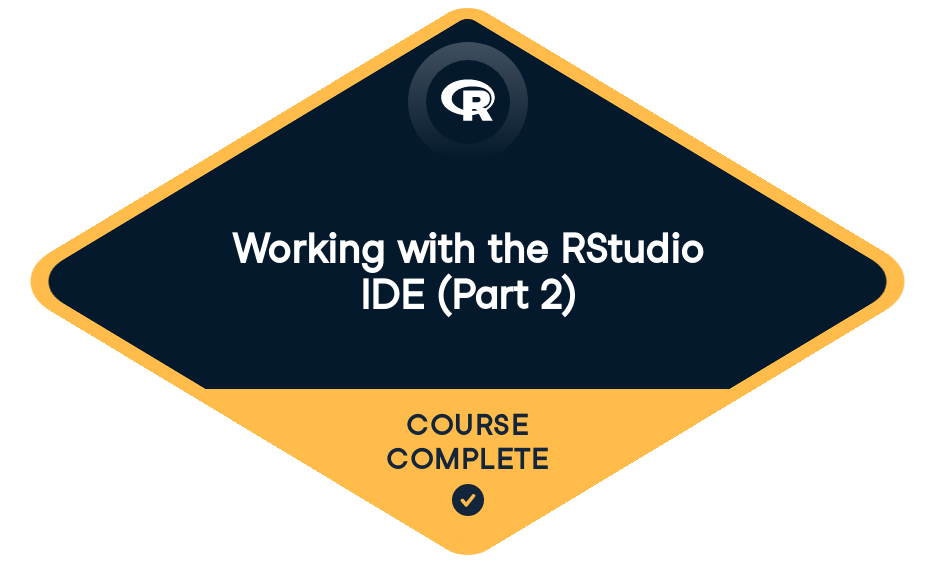
Loved by learners at thousands of companies
Course Description
Learn how RStudio makes it easy to build your own R packages, how you can integrate with your favorite version control software like Git and GitHub for maximum productivity, and finally how to make use of tools like R Markdown, LaTeX, and Shiny for reporting your results to the relevant stakeholders.
This is the second part of a two-part course on how to use RStudio. Part 1 covers the basics of working with RStudio.
Training 2 or more people?
Get your team access to the full DataCamp platform, including all the features.- 1
Packages
FreeThis chapter takes you through the process, from start to finish, of building your own R package in the RStudio IDE. You'll see how the tools provided in the IDE make package development accessible (and fun) for everyone!
Introduction to R packages50 xpCreate a new R package50 xpTo update or not to update50 xpImport & load source files50 xpAdd some R scripts50 xpWhere are the scripts now?50 xpLoading files50 xpPackage documentation50 xpStart with a skeleton50 xpWriting documentation50 xpA helping hand with documentation50 xpPackage documentation (2)50 xpFilling in some documentation50 xpPackage documentation (3)50 xpRender your help page50 xpTest your package50 xpHow to test your package - the basics (1)50 xpHow to test your package - the basics (2)50 xpTest your package (2)50 xpTest script structure50 xpTest your functions50 xpTest your package (3)50 xpTime to test your package50 xpCheck your package50 xpTime to check your package50 xpBuild your package50 xpKeyboard shortcut to build your package50 xpTime to build your package50 xpAvoid overwriting your packages50 xpWrap-up50 xp - 2
Version Control
In this chapter, you'll practice using RStudio's version control interface. You'll start with the basics, like how to turn on version control using Git in an existing directory. Then, you'll see how to track changes to files over time, explore your commit history, get rid of unwanted changes, and how to push changes to remote repositories on GitHub.
Introduction to Git50 xpVersion control in the RStudio IDE50 xpWhat is a commit?50 xpInitializing Git50 xpStage & commit50 xpGetting comfortable with commits (1)50 xpGetting comfortable with commits (2)50 xp.gitignore50 xpUsing .gitignore50 xpGit icons50 xpLooking at Git icons (1)50 xpLooking at Git icons (2)50 xpCommit history50 xpExploring commit history (1)50 xpExploring commit history (2)50 xpUndo commited changes: checkout50 xpUsing checkout50 xpUndo uncommitted changes50 xpUndo changes50 xpIntroduction to GitHub50 xpDownloading packages with GitHub50 xpPull & push50 xpUsing pull & push50 xpWrap-up50 xp - 3
Reporting
This chapter covers the basics of working with three popular reporting tools in RStudio: R Markdown, Shiny, and LaTeX. The goal is to make it as easy and enjoyable as possible for you to document your analyses in a reproducible way and share your results with others.
Tools for reporting50 xpTools covered in this chapter50 xpIntroduction to R Markdown50 xpR Markdown - the basics (1)50 xpR Markdown - the basics (2)50 xpR Markdown in RStudio50 xpDocument types in R Markdown50 xpR Markdown templates50 xpRendering R Markdown50 xpKnitting your documents50 xpAdding Shiny50 xpCompile notebook50 xpUsing compile notebook50 xpRStudio's LaTeX editor50 xpLaTeX and reporting50 xpWorking with LaTeX files (1)50 xpWorking with LaTeX files (2)50 xpShiny50 xpUsing Shiny apps (1)50 xpUsing Shiny apps (2)50 xpPublish Shiny apps50 xpTime to publish your Shiny app!50 xpHow many Shiny apps can you have?50 xp
Training 2 or more people?
Get your team access to the full DataCamp platform, including all the features.collaborators

prerequisites
Introduction to RJoin over 18 million learners and start Working with the RStudio IDE (Part 2) today!
Create Your Free Account
or
By continuing, you accept our Terms of Use, our Privacy Policy and that your data is stored in the USA.